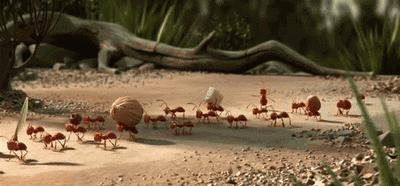
In 1936, ant biologist T.C. Schneirla stumbled upon an interesting phenomenon in which hundreds of marching ants spun around on the ground.
This strange phenomenon of marching ants lasted all day, and even a heavy rain did not stop them. By the next day, most of them had died of exhaustion, leaving only a few dozen in a weak whirlwind, with no intention of stopping.
This is an interesting phenomenon, and generally only marching ants will appear frequently, as they are more commonly moved in swarms.
Now there is a figurative term to explain this phenomenon - the death vortex of ants, a group of ants that keep spinning until death.
As strange as it sounds, this "ant death vortex" is only fatal to the ants involved. Not the entire marching ant "legion" is affected.
So what exactly makes these ants look crazy? It all has to do with how unique they are evolutionarily, and their dominant characteristics create some special disadvantages.
Blind marching ants
If you enjoy watching wild adventure movies, you're probably familiar with the marching ants, a terrifying creature of South America that spreads so much that it can strip animals from the entire forest floor bare.
The ferocity of marching ants is truly true, and they have no permanent nesting site. Ant colonies do not live in a single location, but often march in swarms in search of food.
Their main hunting targets are insects and arachnids, but as depicted in the movie, they also eat birds and other small animals in their path, and the fearsome marching ants can kill a small bird with four stabs.
However, they have a weakness - blindness, in fact, most of the ant's eyes are ornamental, almost entirely through the sense of touch and smell to communicate, while the marching ant is completely blind.
When the first marching ant moves through the procession, it leaves traces of pheromones, and other ants sniff out and follow. When the system works well, it allows foraging teams to lead larger teams back to where the food is.
However, when it makes a mistake, it can guide the ants behind it to simply rotate in a circle.
When there are ants that leave the wrong information for the ants behind them in the process of advancing, all the ants will flow along the trail of pheromones, enter an endless cycle, and eventually go to extinction.
If this vortex hadn't burst, they might never have escaped.
How to create an ant death vortex
The largest recorded edifice of death is more than 360 meters wide, and it takes more than two hours for the peripheral ants to complete a lap.
But this is only a special example, most ant death vortex is only a few centimeters wide, and there are only a few dozen ants inside.
In fact, it is possible to artificially create such a small ant death vortex by simply transferring some ants to an enclosed space, where they can cycle according to their own smell.
For example, put five or six ants in a dinner plate, they will start to look for smell, and then accidentally follow the smell around the plate, one ant begins to do this, and the other ant follows the pheromone to keep up.
Small swirls like these are lethal for individual ants, but won't have any effect on entire colonies made up of hundreds of thousands of ants.
Interestingly, when this interesting ant death vortex appears, other nearby ant species take advantage of this, and various small ants will carry the carcasses of marching ants in the whirlpool.
At last
There are more than 200 species of military ants living on both sides of the planet, but genetic evidence suggests that they may all be common ancestors, and their evolutionary strengths and weaknesses have been preserved for more than 100 million years.
All marching ant species share common traits: collective foraging, nomadic life, and wingless queens (through which ants reproduce offspring), and these morphological and behavioral similarities force them to adopt collective behavior, where individual ants cannot survive alone.
There is no doubt that evolution has provided marching ants with a successful survival strategy, but it may also leave them with a "side effect", a "pathological" behavior - "the magic circle of love".